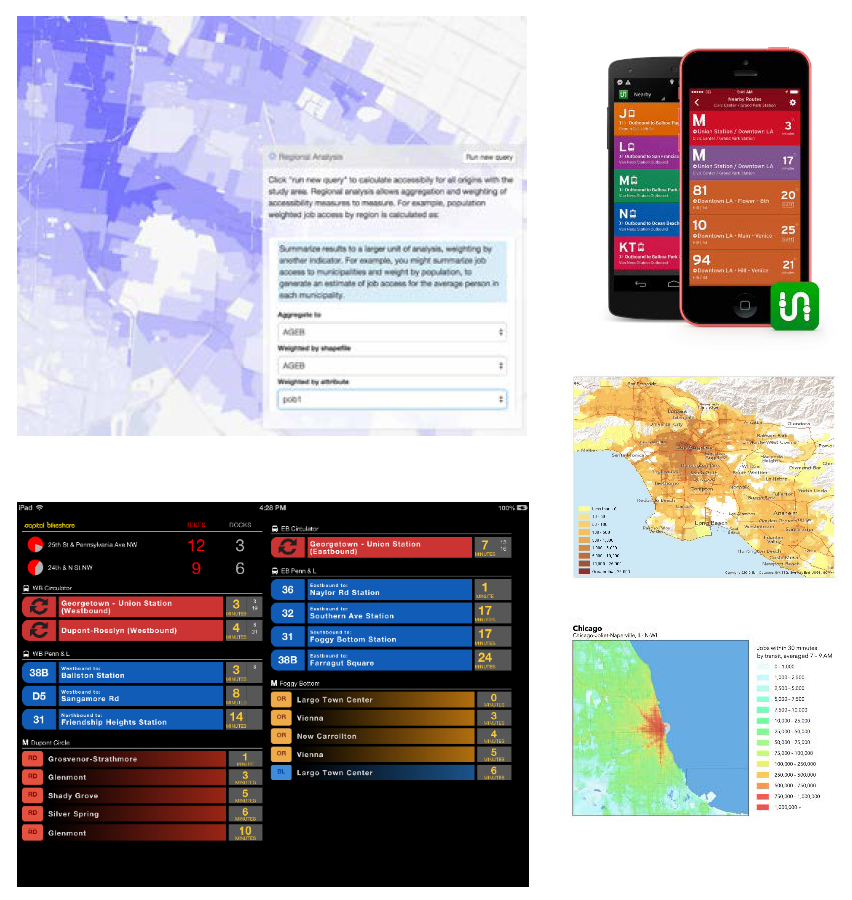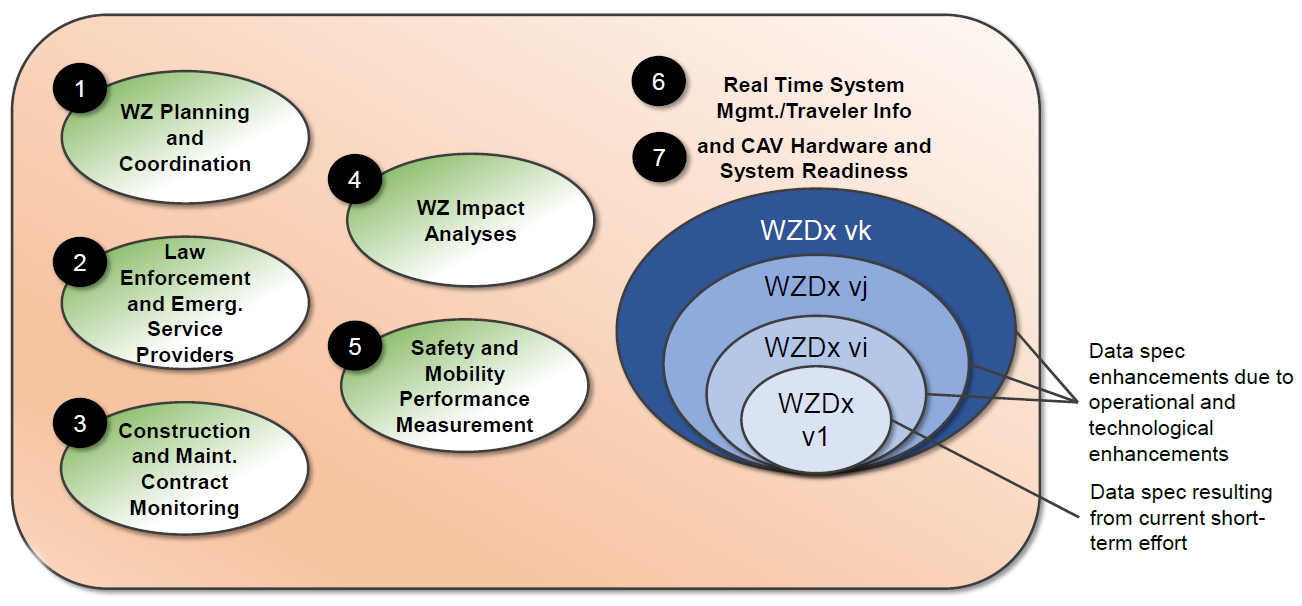FHWA National Dialogue on Highway Automation
Seattle, WA
August 1-2, 2018
Printable Version [PDF 2.6 MB]
You may need the Adobe® Reader® to view the PDFs on this page.
Contact Information: HighwayAutomation@dot.gov
Slide 1. FHWA National Dialogue on Highway Automation
Digital Infrastructure and Data
Double Tree Hilton Seattle Airport, Seattle, WA
August 1-2, 2018

Slide 2. Levels of Automation

Slide 3. USDOT Modal Agencies and Roles

Slide 4. FHWA Authority and Role
FHWA has multiple roles:
- Administers the Federal-Aid Program
- Develops standards for infrastructure and traffic control devices
- Provides guidance to State and local agencies
- Conducts and supports highway research
- Serves as a resource for the transportation community
- and others….
Slide 5. USDOT Activities in Automation
Event |
Date |
| USDOT releases Automated Driving Systems (ADS) 2.0: A Vision for Safety |
September 12, 2017 |
| Roundtable on Data for Automated Vehicle Safety |
December 7, 2017 |
| Public Listening Summit on Automated Vehicle Policy |
March 1, 2018 |
| Automated Vehicles 3.0 announced |
Late Summer 2018 |
| Work Zone Data Exchange Project |
Ongoing |
| V2X Mapping Stakeholder Input |
Ongoing |

Slide 6. USDOT RFIs in March 2018
FHWA RFI Themes
- Greater Uniformity and Quality in road markings and traffic control devices would enable automation.
- FHWA should take a Leadership role in convening stakeholders to encourage collaboration.
- Certain Data Elements around the roadway environment are useful for industry, State, and local DOTs to share and could improve automation operations.
- Conducting Pilots and supporting pilot testing are important for facilitating learning and collaboration.
- Uncertainty in infrastructure investment and allocation of limited resources are key concerns for State and local agencies.

Slide 7. Automation Has Implications for Roadways

Slide 8. The National Dialogue on Highway Automation
Slide. 9 What is the National Dialogue?
- The Federal Highway Administration (FHWA) is initiating a national conversation with diverse stakeholders to discuss automated vehicles.
- The National Dialogue on Highway Automation is a series of meetings held across the country to facilitate information sharing, identify key issues, and support the transportation community to safely and efficiently integrate automated vehicles into the road network.
Slide 10. What are Desired Outcomes?
FHWA may use inputs to:
- Assess National issues and priorities
- Develop guidance, best practices, standards
- Support necessary research
- Adapt programs and policies
- Create a National community or coalition
Slide 11. Schedule
| Month |
Event |
Location |
| June 7 |
National Dialogue Launch Workshop |
Cobb Center, Detroit, MI |
| June 26-27 |
National Workshop 1: Planning and Policy |
Science History Institute
Philadelphia, PA
|
| July 12 |
Automated Vehicle Symposium
FMCSA-FHWA Truck Automation Listening Session |
Hilton, San Francisco, CA |
| August 1-2 |
National Workshop 2: Digital Infrastructure and Data |
DoubleTree Hilton Seattle Airport
Seattle, WA |
| September 5-6 |
National Workshop 3: Freight |
Hyatt Regency Chicago, Chicago, IL |
| October 24-25 |
National Workshop 4: Operations |
Phoenix, AZ |
| Week of Dec. 3 |
National Workshop 5: Infrastructure Design and Safety |
Austin, TX |
Slide 12. Data and Digital Infrastructure
Slide 13. Today's Discussion
- Understand how components of digital infrastructure may assist in the development and safe deployment of automated driving systems.
- Discuss roles and responsibilities of government (federal, state, and local), private industry, and even road users, to provide, support, manage, or operate components of digital infrastructure in support of surface transportation.
Slide 14. Illustration of Digital Infrastructure

Slide 15. Automation, Data, and Digital Infrastructure
- AVs process static and/or dynamic digital representations of the physical world in which they interact.
- AVs need many types of infrastructure data to safely integrate into the roadway.
- Infrastructure owners/operators need data to efficiently manage the roadway system.
- Digital infrastructure enables the efficient collection, processing, and exchange of data using components.
Slide 16. Agenda Day 1
| Time (PDT) |
Agenda Item |
| 12:30 PM |
Registration and Sign-in |
| 1:00 PM |
Opening Remarks |
| 1:10 PM |
National Dialogue Overview |
| 1:25 PM |
Framing the Discussion |
| 1:40 PM |
Small Group Session 1: Data for Integration of AVs
Small Group Discussions with Facilitators and Co-Facilitators at each table |
| 2:50 PM |
Small Group Session 1 Report Out |
| 3:30 PM |
Break |
| 3:45 PM |
Collaboration Corner
Market Square Format: Participants rotate around to different stalls to provide input on various topics |
| 5:00 PM |
Wrap-up and Preparation for Day 2 |
| 5:30 PM |
End of Day 1 |
Slide 17. Agenda Day 2
| Time (PDT) |
Agenda Item |
| 7:30 AM |
Registration and Sign-in |
| 8:00 AM |
Kick-off Day 2 |
| 8:15 AM |
Instructions for Small Group Session 2 |
| 8:20 AM |
Small Group Session 2: Digital Infrastructure
Small Group Discussions with Facilitators and Co-Facilitators at each table
|
| 9:30 AM |
Small Group Session 2 Report Out |
| 10:00 AM |
Break |
| 10:20 AM |
Preparing for Automated Vehicles: Digital Infrastructure and Data Perspectives |
| 11:30 AM |
Lunch (not included) |
| 1:00 PM |
Small Group Session 3: What's Next?
Each table selects a primary and secondary topic to address |
| 2:30 PM |
Wrap-up and Next Steps |
| 3:00 PM |
End of Day 2 |
Slide 18. Contact:
HighwayAutomation@dot.gov
Slide 19. Data for Automated Vehicle Integration

Ariel Gold
Data Program Manager
US Department of Transportation (USDOT)
Intelligent Transportation Systems Joint Program Office (ITS JPO)
August 1-2, 2018
Slide 20. How to Take on a Cross-cutting Issue Like Data?
Access to data is a limiting factor for AV deployment. (It's also a sensitive topic.) One solution: data exchanges.
USDOT is using our convening power to understand critical use cases for data exchange and the appropriate federal role to enable them.
Slide 21. Bringing Stakeholders Together for Meaningful Conversations on Data
(It's really hard to do)
Slide 22. AV Data Guiding Principles (Beta)
- Promote proactive, data-driven safety, cybersecurity, and privacy-protection practices.
- Act as a facilitator to inspire and enable voluntary data exchanges.
- Start small to demonstrate value, and scale what works toward a bigger vision.
- Coordinate across modes to reduce costs, reduce industry burden, and accelerate action.
https://www.transportation.gov/AV/Data
Slide 23. AV Data Framework (Beta)
| Category* |
Goals |
Specific Data to Exchange |
Real-World Examples |
| Business-to-Business (B2B) |
- Mitigate known and emerging cyberthreats
- Improve industry-wide safety through shared learning in safety-critical and edge case scenarios
- Inform future insurance policies
- Accelerate the resolution of legal liability claims
|
- Cybersecurity incidents
- Edge cases
- Near-miss events
- Performance in safety-critical scenarios
- Post-accident data
|
|
| Business-to-Government (B2G) |
- Understand performance of rapidly evolving technology during testing phases
- Inform policies and investments to improve system safety and efficiency
|
- Cybersecurity incidents
- Near-miss events
- Performance in safety-critical scenarios
- Crash reconstruction
|
|
| Business-to-Infrastructure (B2I) |
- Help vehicles navigate safely around obstacles and in adverse weather conditions
- Reduce system congestion
- Help optimize infrastructure maintenance
|
- Work zone activities and geometrics
- Road weather information
- Missing signage or broken infrastructure
- Curb use rules and availability
|
|
| Open Training Data (X2X) |
- Improve ADS performance in common safety-critical scenarios
- Support basic research and education
|
- Road, signage, and other infrastructure imagery
- Edge cases
- Bike/ped near misses
- Truck platooning pilot data
|
|
*represents two-way data exchange
https://www.transportation.gov/AV/Data
Slide 24. Roundtable on Data for AV Safety
Outcomes
- Clarity on value of federal government as convener and facilitator
- Priority use cases for data exchange: work zones, scenarios, cybersecurity, others
Next Steps
- Enable voluntary data exchanges as "One DOT" via pilot projects
- Incorporate into AV policies
- Continue conversations
 Photo credit: Dan Morgan
Photo credit: Dan Morgan
Slide 25. Work Zone Data Exchange Project
The Local Data Challenge
Slide 26. The Local Data Challenge
Up-to-date information about dynamic conditions occurring on the roads—such as construction events—can help AVs navigate safely and efficiently.
Many infrastructure owners and operators (IOOs) maintain data on work zone activity, but lack of common data standards and convening mechanisms makes it difficult and costly for third parties—including original equipment manufacturers (OEMs) and navigation applications—to access and use these data across various jurisdictions.
Slide 27. Learning from the Open Transit Data Story
A simple specification…

…with a wide range of uses

Slide 28. A Federated "Front Door" to Transit Data
Now, basic transit data is easy to find and use nationwide; transit agencies and their users continue to collaborate on the spec

Slide 29. Work Zone Data Exchange Project (Overview)
Purpose
- To jumpstart voluntary adoption of a basic work zone data specification
- To enable collaborative maintenance and expansion of the spec
Outcomes within 6 months
- Data producers make available an active work zone data feed using a common, non-proprietary specification
- Non-government developers use that data in a meaningful way—thus establishing a minimum viable product of voluntary data exchange for work zone data
Big Picture Outcome
- Repeatable approach to accelerate harmonization of local data sources
Slide 30. Work Zone Data Exchange Project (Notional timeline)

- Feb 2018: Charter project
- Mar 2018: Kick off
- May 2018: USDOT synthesizes inputs from data providers and produces strawman data dictionary based on existing data sources
- June 2018: Reach consensus on data dictionary (common core, extensible fields for future) and encoding spec
- July 2018: Users validate sample data; lock in data dictionary v1
- July 2018: Data providers implement the common spec; data users demonstrate use of the data
- Aug 2018: Promote broadly; Start process of adding new fields for v2
-
Technical assistance (immediate, and TBD longer term)
Discover AV-specific needs that go beyond current data feeds
Establish mechanism to maintain and expand spec in future
Slide 31. Longer-term Needs Discovery (FHWA Work Zone Data Initiative)

Slide 32. Relationship between Data & Digital Infrastructure for AV Integration
Hint: Data = Digital
Slide 33. A Range of Potential Federal & Non-Federal Roles
Slide 34. Recap: Meaningful Conversations on Data
- Start with the "why"— what problem are you trying to solve through data?
- Then talk about "who" needs to be involved, and "what" data they're exchanging
- Then dive into "how" to make this happen
- Consider using the AV Data Framework and Principles to jump-start your conversations (start small and scale)!
Slide 35. Thank You!
www.transportation.gov/av/data
ariel.gold@dot.gov
AVDX@dot.gov
Slide 36. Disclaimer
The Federal Highway Administration (FHWA) does not endorse any entity and the appearance of our presentation material in this template should not be interpreted as an endorsement or statement exhibiting any preference, support, etc.
















